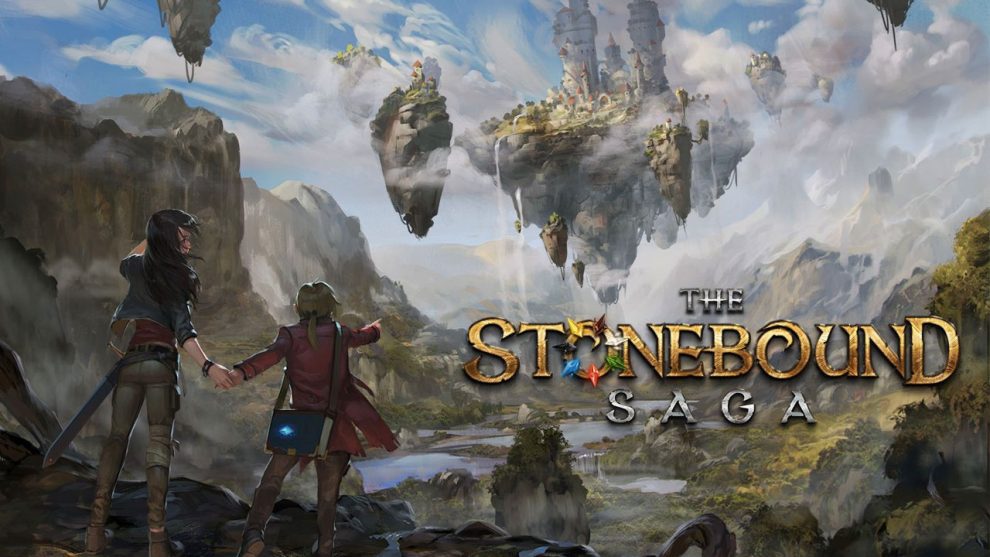Stonebound Saga is the weird child in the Skirmish board game family. Instead of dozens of miniatures, you are given cards to represent your troops. It’s even hard to call them troops since you only control three characters but these characters can have numerous abilities that can only be triggered by a card draw. You don’t roll to hit your opponents; you only roll to see if you hit harder. Each hit that damages your target will permanently reduce their armor for the rest of the match.
This is a very unconventional skirmish game.
Storytime. There is a looming threat in Telios and numerous people from various nations have come together in the floating capital city of Lux to train their newfound powers. It is in training ground that they will learn how to stab, poison, bludgeon, cripple, and freeze their foes in a magically protected environment where mortal wounds would only lead to unconsciousness.
You play as a commander of these fine soldiers and try to come up with the best three-person team either in a constructed format or, my favorite, drafting format. Your rival commander will do the same and it is your job to beat them into submission. Sounds easy, right? Just pick from 3 people from 70 characters and…
Wait, How Many Characters?
That wasn’t a typo. 70.
This is not a Kickstarter stretch goal exclusive nonsense. You will get that number of characters in the standard retail box. Each character will also have six to twelve different abilities. In other words, there are roughly 300 abilities to abuse and experiment with. The criticism here is it will be overwhelming for new players and even experienced players might have trouble grasping the dozen or so abilities their team will have.
As someone who used to play a lot of skirmish games like Summoner Wars, Krosmaster Arena, and Battlelore, the amount of content in Stonebound Saga outshines every other game in terms of value. If you are playing a two-player session, you will create a team of 3 different characters. The drafting variation uses 15 out of the 70 character roster. As you can see, there are plenty of ways this game can be approached.
/pic5131225.png)
Each character is associated with a class and several Speaking Stones. The class is the type of stats the character will have, such as the Watchman being slow but highly defensive against Physical attacks but weak against Spirit attacks. Classes will also have a certain playstyle such as Prophets being ranged Spiritual spellcasters and Vanguards focused around physical range combat.
The Speaking Stones represent the character’s elemental powers that they will use in the fight. Think “Land” from Magic the Gathering. These elements are tied to certain mechanisms and there are defensive and offensive versions of them. For example, defensive Water abilities are focused around support, while offensive Water abilities are focused around movement manipulation and freezing opponents. This doesn’t mean a Watchman’s defensive water abilities are the same as the Prophet’s, but they follow a similar playstyle.
After selecting your elite team, you will slap them on your end of the board and your opponent will do the same on their end. The board? It’s grid-based with no height, line of sight, or obstacles.
/pic5131226.png)
Classical Grid-Based Combat
I’ll admit that this scared me at first because we are conditioned to expect more from our skirmish games with complicated mechanisms just to move your plastic doll around the board. However, Stonebound Saga ditches all that silly nonsense for something that is understandable by normal human beings. It’s refreshingly simple.
The very first thing you will do on your turn is to draw your Speaking Stone cards. These cards represent the elemental powers that you can use to trigger your team’s special abilities. However, not every elemental can help your team, so you might be in a situation where your hand is pretty much dead. We’ll get to that in a bit.
After examining your hand, you will select one character on your team, do their actions, and move on to the next character to do it all over again. Once all of your characters have been activated, your turn ends.
Each character can do three different actions in any order: Move, Fuse, and Attack.
Move is as straightforward as it sounds. You move the number of spaces equal to your character’s movement in an orthogonal fashion. You can move through your allies, but may not land on them, while enemies will block your movement.
Fuse is an interesting one. Some characters have “Fuse Abilities” that they can activate. Think of these as buffs such as increasing your character’s attack range or whenever you take damage, the attacker is blinded for one turn. The catch is that any Speaking Stone cards used are laid in front of you and count towards your hand limit until you decide to break your Fuse ability.
/pic5131228.png)
Since we are on the subject, every ability requires a certain number of Speaking Stones of the same type. In the above example, to use “Light”, you would two Light stones to cast it. Each Speaking Stone card is worth 1 to 3 stones of a particular type and there is a “wild” Stone type as well. There is also an infinite version of the 8 types of Speaking Stones in the game. You can use multiple cards of the same type to use an ability.
Finally, there is the Attack action. You can choose to do a free Standard Attack or use one of your abilities by playing Speaking Stones cards. Standard Attack is a straightforward affair: You roll to see if you get a critical hit. If you do, double your damage. Afterward, you reduce your damage by the defense of the enemy depending on your attack’s damage type (Physical or Spirit damage). For example, my Watchmen does 4 Physical damage, my opponent’s Physical Defense is 2, so I deal 2 damage to them. If the opponent received any damage, they reduce their defense by 1, or by 2 if it was a Critical Hit.
That last sentence is one of Stonebound Saga’s greatest innovations. It is such a stupidly simple rule that changes the skirmish genre over its head.
Simplistic Innovation
For starters, it introduces an arc without the need for “upgrades” or “leveling up” like many other skirmish games tend to do. By reducing the defenses of your characters for each hit, it forces a timer into the system outside the usual round limits. The start of your battle is more like testing your opponent’s skill and abilities since the first few hits aren’t significant. Towards the mid and end game, where characters’ armors are shredded, each hit has some weight to it and a well-timed Critical Hit feels like a dropkick to the throat.
This also rewards proper aggression. Since each point of damage leads to a permanent defense loss, you are encouraged to attack your opponent so you can set yourself up for deadlier abilities in later rounds. The best part about this is you don’t need to rely on card draws to do this. Even if you don’t draw cards related to your characters, doing the free Standard Attacks is still productive. In fact, you’ll find most of the abilities in this game to be Standard Attacks with something special such as a status effect like Freeze or Poison. At most, the abilities will give you an edge but proper team composition and positioning will always beat a good hand of Speaking Stones.
Usually, I detest randomness in my skirmish games and it was one of the primary reasons why I avoided miniature games like Warhammer or Heroscape since I felt my agency was merely an illusion due to the numerous dice rolls. Stonebound Saga is smarter than this and manages to turn randomness into an interesting dilemma for the players.
I have already mentioned how the Critical system awards aggressive tactics, but the use of the Speaking Stones introduces several layers. The first obvious tidbit is your team composition. It forces you to pick characters with different elements since you want to make the most use of any drawn cards. Having your team have overlapping elements isn’t a good idea since it means your hand draws will suffer and your team’s abilities might not be able to fire off as often as you like.
/pic4136202.jpg)
Besides team composition, it also means that you have to approach this game in a very tactical way. Your team composition is the strategy, but the battle itself is all about the turn-by-turn plays. Using cards drawn from a common deck to use abilities means that you have to constantly evaluate what your options are each turn and you cannot rely on a powerful ability or two since you might not be able to use them in a timely manner. This sounds like a terrible experience, however since the tactical game is still focused on positioning and you always have the freebie Standard Attack alternative, it works quite well. It puts random elements in the game that make each game dynamic without compromising player agency.
I prefer Stonebound Saga’s approach to randomness in the skirmish genre over many of its predecessors. I also like how this game still offers some deterministic elements without forcing each player to play in a very “optimal” way that I tend to see in more Euro-style skirmish games. It is also one of the few games out there that offer a 2 vs 2 or 3 vs 3 variant but suffers at odd player counts. Just a bit of a warning the team play elements can make the game drag for players who tend to overthink their moves.
About That Rulebook…
Now let’s talk about the stuff I dislike about the game. To keep it brief, I have no problems with the game’s mechanisms, content, or artwork. My complaints are easily fixable in a 2nd edition or re-printing.
I have taught many games throughout my years and I have read many rulebooks. Stonebound Saga’s rulebook is so vague and open for interpretation that it feels more like a religious scripture than a board game rulebook. It does a good job showing you the ropes such as what a Fuse ability, how turns are structured, or what do the keywords mean. The issue lies in edge cases and timings.
For example, there are plenty of defensive and offensive abilities that could trigger multiple dice rolls in a single action. Is there a certain order of abilities to trigger? If my character has both Evasion and Negate, which one do I roll first? Do I roll critical after the defensive abilities trigger?
The game is also very reliant on the ability cards to explain the rules, but due to the wording of some of the abilities, they can be interpreted in several ways. As for the ability cards themselves, they are not designed very well since the text is small with a very questionable two-column layout. The ability cards I have used here in the review are from the Visions of Telious expansion, which is a huge improvement but still has issues with the wording.
As I have mentioned, all of this can be fixed with an editor to reword the vague parts and to be more clear on the game designer’s intentions.
As a word of caution, the game’s competitive nature highly rewards understanding the characters and combinations. Having a poor team composition or performing bad plays will result in one side enjoying the game while the losing side delaying the inevitable. The experiences can be very inconsistent and there were a few games where one side would simply forfeit since it was mathematically impossible to win. It sometimes felt like a well-balanced match is due to coincidence instead of the player’s skill or game mechanisms. It also doesn’t help that managing your team of three characters trying to make use of 20 different abilities can be overwhelming for new players. Despite the easygoing approach and little rules overhead, this game is very unforgiving.
It has been a while to see a game that manages to have a very straightforward ruleset yet manages to have dense gameplay from the start of the game all the way to the bitter end. Creating your small team with cool abilities while using a card draw mechanism to cast these abilities sounds insane but works in this game due to the various alternatives to bad card draws. To put it briefly, if you want something outside of purely deterministic games but don’t like the high randomness of the typical American style skirmish games, this hybrid could be worth checking out.










